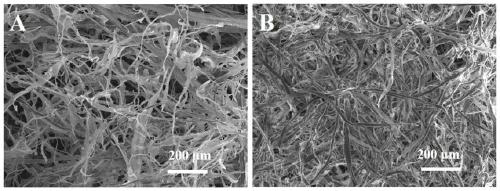High-flux emulsion separation composite material and preparation method and application thereof
An emulsion separation, high-throughput technology, applied in separation methods, liquid separation, immiscible liquid separation, etc., can solve problems such as limiting the large-scale application of superwetting separation membranes, reducing separation flux, and achieving good mechanical stability. performance, high flexibility, improved separation efficiency
- Summary
- Abstract
- Description
- Claims
- Application Information
AI Technical Summary
Problems solved by technology
Method used
Image
Examples
Embodiment 1
[0024] (1) Add 10 g of cotton fiber per liter of water at room temperature, mechanically crush and disperse it to obtain cotton fiber pulp; calculate 50 mL of cotton fiber pulp per square centimeter, put a part of cotton fiber pulp into a vacuum filtration device and vacuum filter it into Membrane, to obtain the membrane layer required for high-flux emulsion separation materials;
[0025] (2) Spread the film layer prepared in step (1) on the bottom of the beaker, and pour the cotton fiber slurry on the surface of the film layer according to 10mL of cotton fiber slurry per square centimeter, freeze at -60°C to form a solid mixture, and freeze-dry porous layer / membrane composite;
[0026] (3) Prepare a N,N-dimethylformamide (DMF) solution of polycaprolactone with a mass fraction of 0.3%, wet the porous layer / film layer composite obtained in step (2), and dry at room temperature A high-throughput emulsion separation material is obtained.
[0027] Calculate the thickness and por...
Embodiment 2
[0030] (1) Add 10 g of sisal fiber per liter of water at room temperature, and mechanically pulverize it to obtain sisal fiber pulp; according to 20 mL of sisal fiber pulp per square centimeter, put a part of the sisal fiber pulp into a vacuum filtration device for vacuum pumping Filtrate into a membrane to obtain the membrane layer required for high-throughput emulsion separation materials;
[0031] (2) Spread the film layer prepared in step (1) on the bottom of the beaker, and pour the sisal fiber slurry on the surface of the film layer according to 5mL of sisal fiber slurry per square centimeter, and freeze at -40°C to form a solid mixture. Freeze-drying the porous layer / membrane composite;
[0032] (3) Prepare a polycaprolactone DMF solution with a mass fraction of 0.5%, wet the porous layer / membrane layer composite obtained in step (2), and dry it at room temperature to obtain a high-flux emulsion separation material.
[0033] Under the same test conditions as in Example...
Embodiment 3
[0036] (1) Add 100 g of viscose fiber per liter of water at room temperature, and mechanically pulverize it to obtain viscose fiber pulp; according to 10 mL of viscose fiber pulp per square centimeter, pour a part of viscose fiber pulp into a vacuum filtration device, and vacuum Filtrate into a membrane to obtain the membrane layer required for high-throughput emulsion separation materials;
[0037] (2) Spread the film layer prepared in step (1) on the bottom of the beaker, and pour the viscose fiber slurry on the surface of the film layer at a rate of 20 mL of viscose fiber slurry per square centimeter, and freeze at -80°C to form a solid mixture. Freeze-drying the porous layer / membrane composite;
[0038] (3) Prepare a polycaprolactone DMF solution with a mass fraction of 0.8%, wet the porous layer / membrane layer composite obtained in step (2), and dry it at room temperature to obtain a high-flux emulsion separation material.
[0039] Under the same test conditions as in Ex...
PUM
| Property | Measurement | Unit |
|---|---|---|
| thickness | aaaaa | aaaaa |
| pore size | aaaaa | aaaaa |
| thickness | aaaaa | aaaaa |
Abstract
Description
Claims
Application Information
 Login to View More
Login to View More - R&D
- Intellectual Property
- Life Sciences
- Materials
- Tech Scout
- Unparalleled Data Quality
- Higher Quality Content
- 60% Fewer Hallucinations
Browse by: Latest US Patents, China's latest patents, Technical Efficacy Thesaurus, Application Domain, Technology Topic, Popular Technical Reports.
© 2025 PatSnap. All rights reserved.Legal|Privacy policy|Modern Slavery Act Transparency Statement|Sitemap|About US| Contact US: help@patsnap.com

